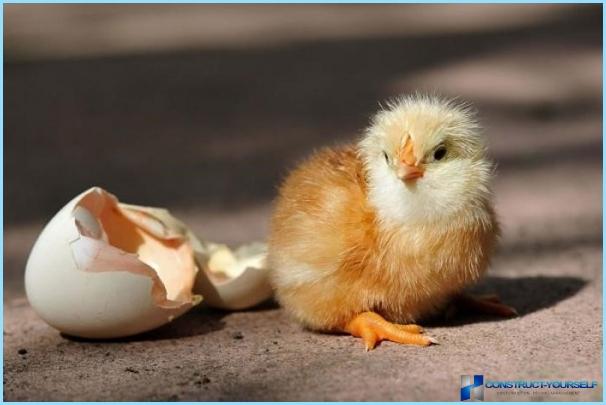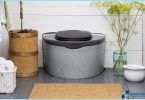Before the owners of farms are regularly faced with the task of replenishment in the number of birds. To rely on the decision of a question with hens is not necessary. Modern breeds of chickens rarely become hens, and the volume of the brood of chickens is negligible. If you add the subsequent reduction of egg-laying hens, the use of the incubator for breeding chickens – the best way out of the situation.
The preparatory stage ↑
If you want to get the Chicks out of the incubator, you should first study all the nuances of the technological process of excretion. To organize activities permitted at any time, but beginners should think about the further contents of chickens. Therefore, an auspicious time – the beginning of the warm season, i.e. laying eggs in April, the removal of nestlings in may. To the effort were not in vain, first of all it is necessary to organize complete nutrition of chickens. In addition to the usual feed during the cold period added to the diet:
- artificial vitamins;
- cake, soaked in boiling water;
- vegetables.
The selection of eggs for breeding purposes ↑
Eggs intended for breeding chickens in an incubator, are carefully selected:
- On an industrial scale, they are subject to weighing at home enough on the eye to assess the size of the egg. Too large and overly smaller specimens are not recommended, the correct solution for removing the incubator – medium size.
- Next, carefully examine the surface of the shell. Substantial assistance in this lesson, you will have an ovoscope. Cracks, growths, bumps or depressions is unacceptable to eggs intended for breeding chickens. If an instance with the notch is a rare breed and is of particular value, experts recommend to put on it a thin strip of glue made of starch. The irregular shape of the eggs – another reason to refuse to lay it in the incubator for breeding chickens.
- The candling helps determine the freshness of eggs. Slightly darkened spot in the center of the blunt end is an air chamber, which increases with each day of storage eggs. Chickens are bred in the incubator of stale eggs, lag behind in development.
- A sharp displacement of the yolk when the rotation indicates a torn the cord, such an instance is subject to rejection.
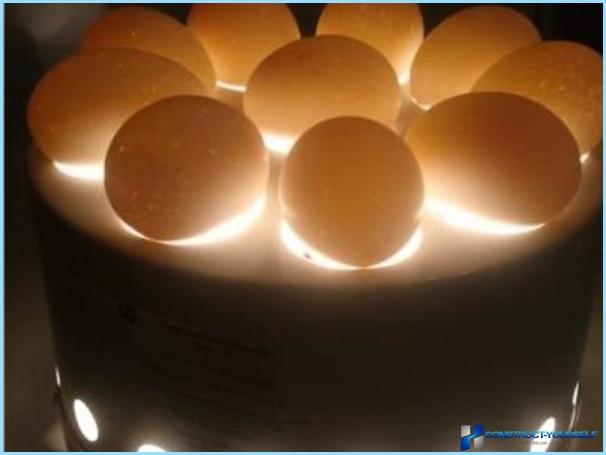
The material selected for the incubator, to be disinfected. Small amounts gently cleaned with a cloth dipped in manganese solution. The major parties are subjected to processing vapors of formaldehyde.
Eggs intended for further space in the incubator for breeding chickens, keep up blunt end in a vertical position. The room temperature in short storage is 18onIf a longer period is necessary to reduce the rate of humidity is about 80%. The maximum period of storage before being placed in the incubator for 6 days, quality bred chickens above, if the eggs were stored not more than 2 days.
Assembly / installation ↑
All devices have differences in performance. Therefore, before beginning the process of breeding chickens, you must read the manual incubator. Prior to the initial planting and after each breeding chickens, the mechanism is thoroughly cleaned by the use of chemicals is prohibited. The new unit it is recommended to check in idle for 3 days, watching the serviceability of all mechanisms and sensors. The incubator is mounted on a flat surface in a well ventilated area, the air temperature which is 22-24onWith and not subject to significant fluctuation during the day. Close should not be heating devices should also exclude the possibility of its heating from sunlight. For humidifying the air during the breeding chickens in an incubator set trays with water. Depending on design, include an incubator for heating for 3-24 hours before placing the eggs.
The contents of the eggs in the incubator ↑
Before laying future chickens, they should be put in a warm room to warm up and avoid sharp temperature decrease in the unit in the first hours after placement of eggs. An incubator for breeding chickens can operate in the mode of automatic turning of the eggs or the need to perform these actions mechanically. In the second case, the eggs are marked with different labels: this can be letters «Have» – morning and «In» – evening, or wand and dagger. The sign does not matter, the main thing is to put it on a simple soft pencil, use markers or other means of chemical basis is unacceptable. Such actions are necessary to control the process of flipping in full. If future chickens differ in size in the first place it is recommended to lay the larger instances, after 5 hours – the average, especially small ones. This will allow to obtain in the incubator of the offspring around the same time.
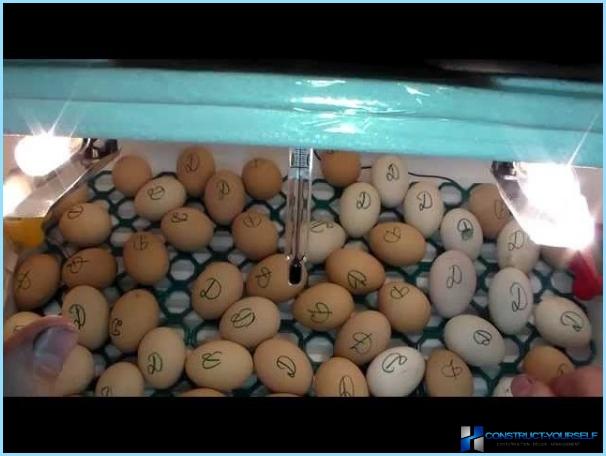
High temperature triggers the development of the embryo at an accelerated pace, however «overheated» chickens are smaller, they often do not have time to overgrown an umbilical cord. Excretion in the incubator with low temperature gives offspring with a delay on the day. The embryo may die before breeding, and the surviving chickens have reduced activity. There is a risk attaching to the shell of the beak and skin of nestlings. The deviation of the level of humidity in the incubator affects the results of breeding chickens.
To avoid future Chicks in the incubator for serious testing, you should examine periods of development of the embryo prior to breeding and optimal conditions for each of them. The formation of Chicks is divided into 4 stages:
- 1 to day 6 after placement in the incubator;
- The 7-10th day of development;
- 12-18 days (before the first peep of chickens not hatched);
- 18th-21st day is the final period of hatching in the incubator.
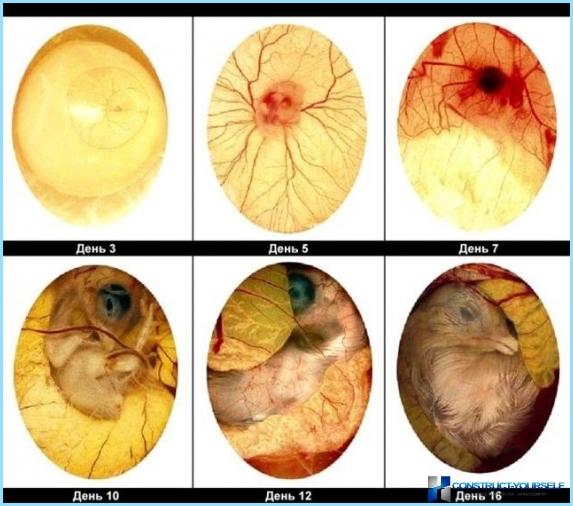
On a piece of development from the first to the third period future chickens are regularly flipping. This will prevent the growth of the embryo to the shell. Experts recommend different time intervals between procedures. Some agree that twice a day is sufficient for breeding of chickens. Others insist on 4 times a day procedures: early morning, late evening and 2 times a day. Rare professionals are advised to turn over every 1-2 hours, when to sleep, even as the owner of an automatic incubator, it doesn’t. The Golden mean in the form of 4-time process during the day – enough for proper ripening of the embryos of chickens in the incubator. Manual steps are performed carefully, when the mechanism should be checked periodically, whether they broke the styling of future Chicks. In the final stage, with the 18th day and the launch of the Chicks in the incubator, the procedure stops turning.
If the volume of insertion in the incubator are not industrial scale, at the end of each period of the formation of the embryo eggs are examined by candling and discarded. Report to new in this period is not recommended due to the distinctive conditions of excretion at different stages. Proper development of Chicks in a separate incubation is impossible without regular airing and spraying to increase the humidity level.
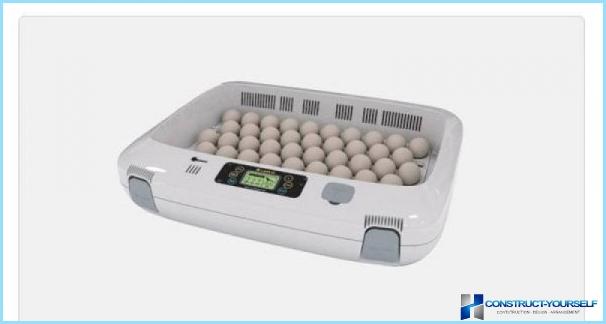
The conditions of detention of the eggs in the incubator to launch in the following table:
| Period | Temperature | Humidity | Airing | Spraying |
| 1 (1-6 day) | 37,7-37,8 | Above 50 % | 5 minutes during the rollover | Not required |
| 2 (7-10 days) | 37,7-37,8 | -«- | -«- | Not required |
| 3 (11-18 days) | 37,1-37,2 | -«- | 5 minutes during the rollover, an additional 1 time per day, starting with 20 minutes and gradually increasing to half an hour. | 2 times a day after turning, after the procedure, the incubator immediately closes |
| 4 (18-21 day) | 36,9-37,1 | 75-80% | 1 times a day 30 minutes | Not required |
Lowering the temperature in the incubator is associated with the development of chicken embryos and independent heat. Increasing the ventilation is due to increased levels of metabolism and growth gas exchange of future Chicks in the incubator. Rely on the automatic incubator is not necessary, it is recommended to periodically check the serviceability of mechanisms, with the possibility of having several devices for measuring temperature, placing them in different parts of the unit.
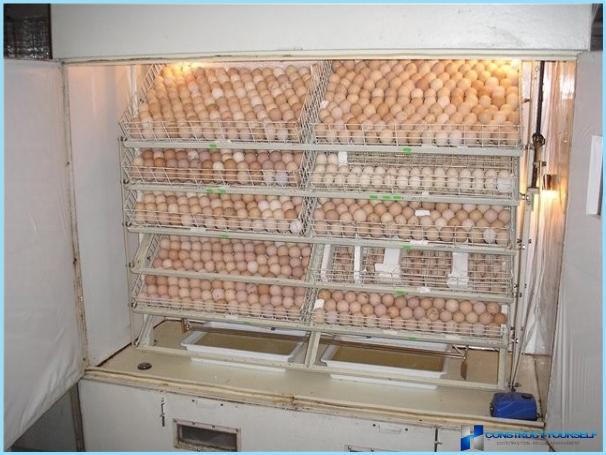
Caring for Chicks in the first days of life ↑
After hatching at 21 days of their leave for a while to dry in the incubator. Subsequently, the Chicks are moved to a specially prepared place (a manger). Healthy individuals have the following characteristics:
- shiny feathers and strong feet;
- respond to sounds and actively moving;
- the eyes of Chicks slightly convex, clear, beak short;
- the cord is soft, the stomach is not sagging.
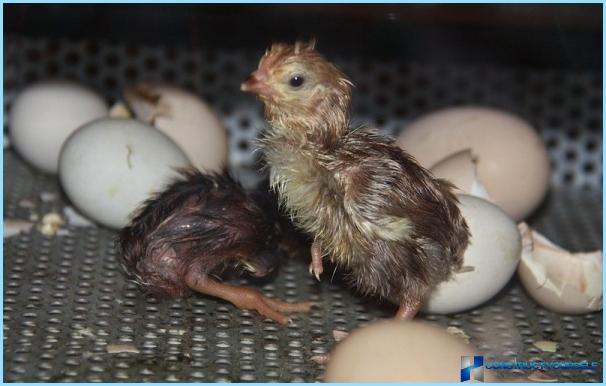
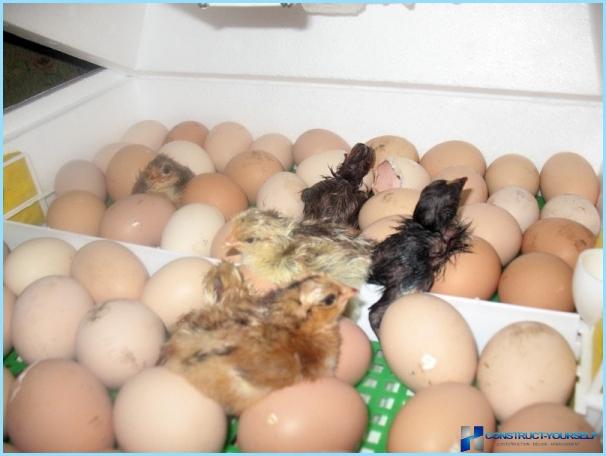
Some deviations in the form of a dried clot of blood, slightly enlarged belly or dim down with mild pigmentation should not be a reason for culling. Due to slight overheating in the incubator the Chicks after hatching may occur umbilical hernia. The problem is solved by sealing the plaster holes, which will be delayed a few days. Weak individuals are recommended immediately to kill him. High mortality immediately after breeding in the incubator is affected by two factors: the low quality of eggs in laying or deviations from the specified incubation conditions.
On the first day after hatching, the Chicks are not able to drink, so they dip his beak into the water and raise their heads to swallow. To reduce mortality it is desirable to treat the Chicks with antibiotics, adding medication in the waterers.
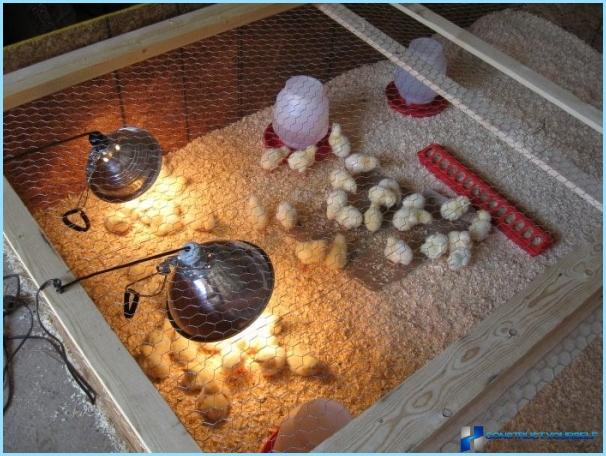
Compliance with the conditions of breeding Chicks in the incubator at all stages will allow you to obtain healthy Chicks with low loss.

